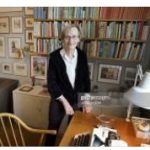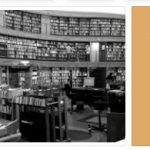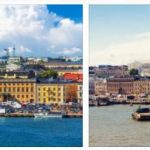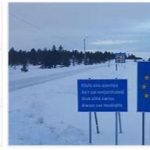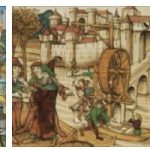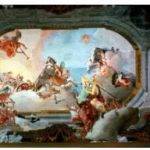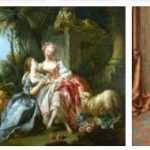Until the conquest by Russia (1809) Finland was considered part of the Swedish Empire and the almost exclusively Swedish-language literature in Finland was considered an integral part of Swedish literature. It was not until the beginning of the 19th century that a remarkable written Finnish literature developed which, over the course of 150 years, pushed Finnish-Swedish literature into the role of minority literature, albeit very active and lively. Finnish-Swedish poets appeared for the first time in the Baroque period. Johan Paulinus Lilienstedt (* 1655, † 1732) and Jacob Frese (* 1690, † 1729), in appearance. However, a specifically Finnish-Swedish movement only developed with the Åbo Romanticism. In the Swedish University of Åbo (Turku in Finnish) national-minded students of the poet Franzén met in 1815 in the »Auroraförbundet« to combine the ideas of Romanticism with the new national consciousness of the Finns. The members of the circle, i.a. Adolf Ivar Arwidsson (* 1791, † 1858), inspired the following generation: E. Lönnrot, who wrote in Finnish, and the Swedish-speaking authors Johan Vilhelm Snellman (* 1806, † 1881) and J. L. Runeberg. In the work, which was also enthusiastically received in Sweden and perceived as “classic” Runebergs unite the tendencies of Finnish-Swedish literature of the 19th century: Mixing classical, romantic and liberalism in connection with a patriotic-Finnish sentiment; Trends such as those adopted by Josef Julius Wecksell (* 1838, † 1907) and Z. Topelius and introduced into bourgeois realism. The change from realism to naturalism took place around 1885 K. A. Tavaststjerna, Jacob Ahrenberg (* 1847, † 1914), Karl Mikael Lybeck (* 1864, † 1925) and Hjalmar Procopé (* 1868, † 1927). A. Mörne became the portrayal of the Swedish-speaking west coast. In Bertel Johan Sebastian As with Jacob Tegengren (* 1875, † 1956), Baron von Gripenberg’s (* 1878, † 1947) sensualistic poetry first found its way into Finland, which was reflected in the pessimistic prose by Ernst Runar Schildt (* 1888, † 1925) and Jarl Hemmer (* 1893, † 1944): E. Zilliacus and Ragnar Rudolf Eklund (* 1895, † 1946) are considered neoclassicalists. – Soon after the Finnish declaration of independence in 1917, European modernism found its way into Finnish-Swedish literature: »Dynamism«, co-founded by Hagar Olsson (Edith Irene Södergran, E. R. Diktonius) influenced modernism in Sweden and at the same time had an impact on Finnish-language literature. The aesthetician Gunnar Olof Björling (* 1887, † 1960) was influenced by Dadaism. Formal modernism was sensitized in the period that followed. Poetry remained the main genre, among others. with R. Enckell, Henry Georg William Parland (* 1908, † 1930), Eklund and Solveig von Schoultz (* 1907, † 1996). The border situation with Russia shaped the novels by Tito Colliander (* 1904, † 1989), while the Ålander Sally Salminen wrote popular novels. Despite the changed political situation, the strong orientation towards the West remains a characteristic of Finnish-Swedish literature even after 1945, which is now noticeably becoming the literature of a small minority (1979: 6.3% of the population) and is therefore closer to neighboring Sweden. This becomes clear in the poetry of Bo Carpelan (* 1926, † 2011) and Thomas Warburton (* 1918, † 2016). Claes Andersson breaks with the long dominant tradition of modernism in his lyrical work; Lars Huldén (* 1926, † 2016) uses his poems among others. critical-ironic with Runeberg apart. A pronounced tendency towards large epic forms can be observed among the authors of narrative prose, Jörn Donner (* 1933, † 2020), Johan Bargum (* 1943), Christer Alfred Kihlman (* 1930) and Henrik Tikkanen (* 1924, † 1984) create social and psychological topics from the world of the Swedish-speaking bourgeoisie, Märta Tikkanen is committed to depicting women’s problems. Kjell Westö (* 1961) describes the social and cultural position of the young generation of a Swedish-speaking minority in Finland.
Linkoping
According to internetsailors,Linköping [ lintçøpi ŋ ], is the capital of the administrative area (County) Östergötland, Sweden, in a fertile plain east of Lake Vättern, 106 500 residents, as a greater community of 1,436 km 2 and 155 800 residents; Bishopric (since the 12th century, now Lutheran); University (founded in 1975), science park; Open-air museum Gamla Linköping (town houses from the 18th and 19th centuries), Östergötlandmuseum, Air Force Museum; Saab AB plants (aircraft construction, armaments industry, data processing, electronics), mechanical engineering, textile and food industry, information technology; Transport hub.
The cathedral, a three-aisled hall church, on the site of a Romanesque church (1st half of the 12th century, north portal preserved) started around 1230, shows influences of the English and German Gothic (choir, end of the 15th century); Altar painting by M. van Heemskerck. The castle (13th and 15th centuries) was expanded in the Renaissance style in the 16th century. The bishop’s court dates from 1733.

